Business
Group Decision Making
Group decision making refers to the process of reaching a consensus or making a choice among multiple options by a team or a group of individuals. It involves sharing ideas, discussing alternatives, and ultimately arriving at a decision that reflects the collective input of the group. This approach can lead to more diverse perspectives and potentially better outcomes than individual decision making.
Written by Perlego with AI-assistance
Related key terms
1 of 5
10 Key excerpts on "Group Decision Making"
- eBook - PDF
- Ricky Griffin(Author)
- 2021(Publication Date)
- Cengage Learning EMEA(Publisher)
Group or team decisions may also represent undesirable compromises. 42 For example, hiring a top manager on a compromise may be a bad decision in the long run because he or she may not be able to respond adequately to various subunits in the organization nor have everyone’s complete support. Sometimes one person dominates the group process to the point where others cannot make a full contribution. This dominance may stem from a desire for power or from a naturally dominant personality. The problem is that what appears to emerge as a group decision may actually be the decision of one person. nominal group A structured technique used to generate creative and innovative alternatives or ideas Group Decision Making has several advantages (as well as disadvantages). This group, for instance, is carefully reviewing possible alternatives for an important decision. The members bring more experience and different perspectives to the decision than might any one of them working alone. At the same time, though, this process will take longer and be more expensive. Monkey Business Images/Shutterstock.com PART 3 | Planning and Decision Making Copyright 2022 Cengage Learning. All Rights Reserved. May not be copied, scanned, or duplicated, in whole or in part. Due to electronic rights, some third party content may be suppressed from the eBook and/or eChapter(s). Editorial review has deemed that any suppressed content does not materially affect the overall learning experience. Cengage Learning reserves the right to remove additional content at any time if subsequent rights restrictions require it. 235 CHAPTER 8 | MANAGING DECISION MAKING AND PROBLEM SOLVING Finally, a group or team may succumb to a phenomenon known as “groupthink.” Groupthink occurs when the desire for consensus and cohesiveness overwhelms the goal of reaching the best possible decision. - eBook - PDF
Multi-objective Group Decision Making: Methods Software And Applications With Fuzzy Set Techniques (With Cd-rom)
Methods, Software and Applications with Fuzzy Set Techniques(With CD-ROM)
- Guang-quan Zhang, Da Ruan, Jie Lu(Authors)
- 2007(Publication Date)
- ICP(Publisher)
Step 1: Define the decision problem Group Decision Making 45 It is important for group decision makers to understand clearly what they are trying to decide so that they have a common goal to focus discussions on and form a problem statement. Step 2: Determine requirements Once group decision makers have defined their decision problem, they will examine the data and resources that they already have, and identify what additional information they may need. Discussion based on information sharing is very important. Step 3: Establish objectives and goals When some opinions on objectives are conflicted with each other in a group, discussion, negotiation, even a voting will be made until an agreement for objectives and goals are accepted by the group. Step 4: Generate alternatives Following the above requirements and objectives, we can generate alternatives for potential solutions to the problem. This involves collecting as many alternatives as possible to make sure group members participate in the generation process. But some similar alternatives proposed by different members should be merged, and a set of alternatives will be finally accepted by the group. Step 5: Determine criteria To identify the criteria would determine whether a chosen solution is successful. Ideally, a solution will be feasible, move the group forward, and meet the needs of group members. Similar criteria will be merged and weights may be given by all members through discussion and negotiation. The individual group member may want to rank the criteria in order of the importance, and an agreement on the weights of the criteria may be needed. Step 6: Select a group decision-making method or tool Based on the situation of the decision group (for example, at the same place or different locations, has a leader or not), a method or tool can be chosen. - eBook - PDF
Making Decisions
Expert Solutions to Everyday Challenges
- (Author)
- 2008(Publication Date)
- Harvard Business Review Press(Publisher)
Making Decisions: The Basics What Is Decision Making? 3 4 Making Decisions A s a manager, you are faced with decisions every day. Some decisions are straightforward, such as deciding which team member to assign to a specific project. Others are more complex, such as selecting a new vendor or deciding to dis-continue a product due to weak sales. Many managers tend to view decision making as an event—a choice to be made at a single point in time, usually by an individ-ual or a small group. In reality, however, significant decisions are seldom made in the moment by one manager or in one meeting. Simply put, decision making is a social or group process that un-folds over time. “Effective executives know that decision making has its own systemic process and its own clearly defined elements.” —Peter Drucker Decision making as a group process Important decisions, such as changing the strategic direction of a group or hiring a new manager, typically require time and input from many individuals and sources of information throughout an organization. Hence, decision making can more accurately be viewed as a group process . Managers who recognize decision making as a group process increase their likelihood of making more effective decisions. Why? By taking time, they are able to identify and assess the issues asso-ciated with making the decision. By involving others, they weigh different perspectives and deepen the discussion. Perhaps most important, taking a process-driven approach is more likely to lead to broader acceptance of the decision—which in turn leads to more effective implementation. Making decisions: eight steps We can think of the decision-making process as consisting of eight steps: 1. - No longer available |Learn more
- (Author)
- 2014(Publication Date)
- University Publications(Publisher)
____________________ WORLD TECHNOLOGIES ____________________ Chapter- 7 Group Decision Making Group Decision Making is a situation faced when people are brought together to solve problems in the anticipation that they are more effective than individuals under the idea of synergy. But cohesive groups display risky behavior in decision making situations that led to the devotion of much effort, especially in the area of applied social sciences and other relevant fields of specialization. There are several aspects of group cohesion which have a negative effect on Group Decision Making and hence on group effectiveness. Risky-shift phenomenon, group polarisation, and group-think are negative aspects of Group Decision Making which have drawn attention. Group-think is one of the most dangerous traps in our decision making. It's particularly because it taps into our deep social identification mechanisms - everyone likes to feel part of a group - and our avoidance of social challenges. But consensus without conflict almost always means that other viewpoints are being ignored, and the consequences of group-think can be disastrous. Issues facing any work group concerning decision making are: how should decisions be made? Consensus? Voting? One-person rule? Secret ballot? Consideration of the various opinions of the different individuals and deciding what action a group should take might be of help. Formal systems • Consensus decision-making tries to avoid winners and losers. Consensus requires that a majority approve a given course of action, but that the minority agree to go along with the course of action. In other words, if the minority opposes the course of action, consensus requires that the course of action be modified to remove objectionable features. • Voting-based methods o Range voting lets each member score one or more of the available options. The option with the highest average is chosen. This method has - eBook - ePub
Communicating Successfully in Groups
A Practical Guide for the Workplace
- Richard Hammersley, Marie Reid(Authors)
- 2014(Publication Date)
- Routledge(Publisher)
9 Group decision-makingWhile it is important to know how and why groups form and operate, at work most groups function to make and implement decisions of various kinds. As we will see in this chapter, group decision-making has certain advantages, but can be flawed. Moreover, in order to make sound decisions it is important that the group functions well, as a group. It is generally not possible to set up a group at work to make decisions, without considering the other aspects of group functioning that we have looked at so far. Groups that do not get on, do not communicate openly, or are run autocratically are more likely to make poor decisions.Objectives
By the end of this chapter you should:- Appreciate the advantages of group decision-making.
- Know the main problems that can occur, including risky shift, polarisation and ‘groupthink’.
- Understand the processes that underlie group decision-making.
- Know some of the traps to avoid in group decision-making.
- Know some techniques for making better decisions in groups.
Decision-making within groups
Many decisions are made in groups rather than by individuals on their own; often it is assumed that a more balanced decision can only be accomplished by a group of people. Some groups are specifically designed for decision-making, including committees, juries, government bodies and quangos, health care teams and company boards. Most groups at work will have to make some decisions and groups have been found to make ‘better’ decisions than individuals in some situations. Some of the perhaps obvious advantages to group decision-making compared with just one person are that a group can have: - eBook - PDF
- Jeff Butterfield(Author)
- 2016(Publication Date)
- Cengage Learning EMEA(Publisher)
Part 4 OBJECTIVES 25 Understand group dynamics 26 Evolve from a group to a team 27 Use divergent thinking 28 Use convergent thinking 29 Reach closure 30 Avoid common group traps 31 Work with large groups 32 Build sustainable agreements Group Decision Making and Problem Solving When confronted with a complex problem or one that affects many people, organizations usually form a group to study the problem and make decisions that lead to a solution. In contrast to an authoritarian style once common in corporations, Group Decision Making and participatory management have grown in popularity over the past few decades. Today, many companies regularly use team-based approaches for organizational tasks. Although you solve problems in similar ways whether you are working alone or as a member of a group, your task can be complicated or enhanced by group dynamics. This unit introduces you to the basics of group dynamics and the ways teams can work together effectively to solve problems. case You have been working with Grace Wong, the vice president of finance at Quest Specialty Travel, to solve business problems for the company. Grace sus -pects that Quest’s future financial health depends on expanding its services to corporate travelers. She talks to Quest employees who were members of other problem-solving groups and asks them to join a new team exploring business travel services. Grace asks you to be a member of the new team. Files You Will Need: PS4-Y26.docx PS4-Y27.docx PS4-Y28.docx PS4-Y29.docx PS4-Y30.docx PS4-Y31.docx PS4-Y32.docx PS4-TechWork.docx PS4-IC1.docx PS4-IC2.docx Copyright 2017 Cengage Learning. All Rights Reserved. May not be copied, scanned, or duplicated, in whole or in part. WCN 02-300 Group Decision Making and Problem Solving Problem-Solving 74 Part 4 Objective 25 Understanding Group Dynamics When working on complex tasks, you cannot do them all yourself. Organizations use groups and teams to make decisions, solve problems, and accomplish goals. - eBook - PDF
Looking Back, Moving Forward
A Review of Group and Team-Based Research
- Elizabeth A. Mannix, Margaret Ann Neale, Elizabeth A. Mannix, Margaret Ann Neale(Authors)
- 2012(Publication Date)
- Emerald Group Publishing Limited(Publisher)
Groups provide a vehicle for getting more and better information, and for fostering the enthusiasm and commitment that will translate more and better information into higher quality decisions and successful decision implementation. Traditionally these benefits of group decision-making have been premised on overcoming barriers to participation of group members. In this chapter, we have explored the related concern that outward participation by group members without their internal engagement may be no better – and potentially worse – than not inviting their decision-making participation in the first place. Thus, the primacy of group member engagement to group decision-making success highlights the importance of managing the social dilemma of group decision-making, in order for organizations to realize the promise of groups. REFERENCES Allan, M. B., Korolis, T. A., & Griffith, T. L. (2009). Reaching for the moon: Expanding transactive memory’s reach with wikis and tagging. International Journal of Knowledge Management , 5 (2), 51–63. Amabile, T. M., Barsade, S. G., Mueller, J. S., & Staw, B. M. (2005). Affect and creativity at work. Administrative Science Quarterly , 50 , 367–403. Asch, S. E. (1958). Effects of group pressure upon modification and distortion of judgments. In E. E. Maccoby, T. M. Newcomb & E. L. Hartley (Eds.), Readings in social psychology (3rd ed., pp. 174–183). New York, NY: Holt. Barsade, S. G. (2002). The ripple effect: Emotional contagion and its influence on group behavior. Administrative Science Quarterly , 47 (4), 644–675. Bartel, C., & Saavedra, R. (2000). The collective construction of work group moods. Administrative Science Quarterly , 45 (2), 197–231. Bazerman, M. H., Curhan, J., Moore, D. A., & Valley, K. L. (2000). Negotiation. Annual Review of Psychology , 51 , 279–314. Bettenhausen, K. L., & Murnighan, J. K. (1991). The development of an intragroup norm and the effects of interpersonal and structural changes. - eBook - PDF
Empowerment and Democracy in the Workplace
Applying Adult Education Theory and Practice for Cultivating Empowerment
- John R. Dew(Author)
- 1997(Publication Date)
- Praeger(Publisher)
Achieving consensus does not mean that everyone in the group agrees with 100 percent of the groups decisions. What consensus means is that at any time, every member of the group is at least 70% com- fortable with each decision the group has made. Consensus is reached through discussion. In this discussion, it is very important that everyone understand the objectives that the group is attempting to meet by making a decision. The discussion needs to con- tinue until everyone can at least give a 70 percent buy-in to the decision. For consensus decision making to work, there must be some degree of cohesion within the group. This means that people want to be part of the group, and share in the purpose of the group. Each person must feel they have an equal voice in the decision-making process, and be willing to com- mit the time and energy to be in dialogue. Participants must start with a willingness to cooperate and a willingness to learn to make consensus-based decisions and to practice this skill. There are common problems that organizations can encounter in build- Consensus Decision Making 119 ing a consensus-based decision making process. First, outspoken individ- uals can dominate the group or organization. Individuals can choose to block an action by taking a strong opposing position to a proposal. This blocking is appropriate if the individual really has legitimate heartburn with a particular proposal, but blocking can become a tactic that causes the group to become dysfunctional over time. If members are too verbose, the process can become too time consuming and can cause participants to burn out. TOOLS TO SUPPORT CONSENSUS DECISION MAKING Consensus decision making can be expedited in any organization through the use of two decision-making tools. The first is a decision-mak- ing flow process called rational decision making and the second is a process known as nominal group technique. - eBook - PDF
- Paul Goodwin, George Wright(Authors)
- 2014(Publication Date)
- Wiley(Publisher)
13 Decisions involving groups of individuals Introduction So far in this book we have focused on the individual decision maker, but important decisions are often made by accountable managers working within small groups of people, most, or all, of whom have information that could be utilized in the decision-making process. Often individuals may differ in their subjective probabilities of events, their utilities of outcomes, or their perception of the future courses of action that may become available as events unfold into the future. If the opinion and values of individuals differ, how should the differences be resolved? Obviously, several individuals who are involved in decision making bring together a larger fund of experience, knowledge and creative insights. It is intuitively reason- able that the chances of overlooking possible events and possible courses of action are diminished in Group Decision Making. Indeed, the synergy of individuals may make the overall quality of the group decision greater than the sum of the parts. The creation of juries, panels and cabinets as ways of reaching decisions can be seen to be based on this premise. This chapter describes and evaluates ways of combining individual judgments to produce ‘improved’ judgments. There are essentially two approaches to the problem: mathematical and behavioral aggregation (although the approaches can be combined). Mathematical aggregation, which we will discuss first, involves techniques such as the calculation of a simple average of the judgments of the individual group members. In behavioral aggregation a group judgment is reached by members of the group communicating with each other either in open discussion or via a more structured communication process. Two simple advantages arise from obtaining group judgments in decision analy- sis. - eBook - ePub
Understanding College and University Organization
Theories for Effective Policy and Practice
- James L. Bess, Jay R. Dee(Authors)
- 2012(Publication Date)
- Stylus Publishing(Publisher)
Many theories deal with decision making. They include process theories, theories about types of decisions, about participation, and about individual predispositions. Understanding the decision-making process allows propitious intervention by organizational leaders. Understanding the decisionmaking structure permits judicious allocation of different types of decisions to decision makers (groups or individuals) who are best able to make the decision effectively and efficiently.Given the prevalence of groups and teams in organizations, collaborative approaches to decision making have become increasingly important to overall organizational effectiveness. If organizations delegate decision-making authority to groups and teams, then members need well-developed communication skills and an awareness of the existing and emergent themes that characterize the group’s communication patterns. Symbolic convergence theory and other social constructionist perspectives on decision making suggest that careful attention must be paid to the group dynamics that shape decision-making processes and outcomes.Review Questions
1. Which of the following reflects the need in every college and university to make decisions to secure adequate resources and assure their efficient distribution (e.g., via budgeting) across various organizational units?a. Adaptation b. Goal attainment c. Integration d. Pattern maintenance and tension reduction (latency)2. A large community college has recruited faculty carefully to assure their agreement with the goals of the college. Many rules and regulations have been developed to direct faculty in the conduct of their classes. In Thompson’s framework, most decisions are likely to be made by:a. Consensus b. Coalition c. Judgment d. Computation3. In some colleges or universities, there may be much disagreement about the institution’s objectives (e.g., transmit knowledge to students versus change their values) and about how to achieve them (e.g., through lectures, discussion, or electronic media). According to Thompson, how are most decisions usually made in such organizations?
Index pages curate the most relevant extracts from our library of academic textbooks. They’ve been created using an in-house natural language model (NLM), each adding context and meaning to key research topics.









